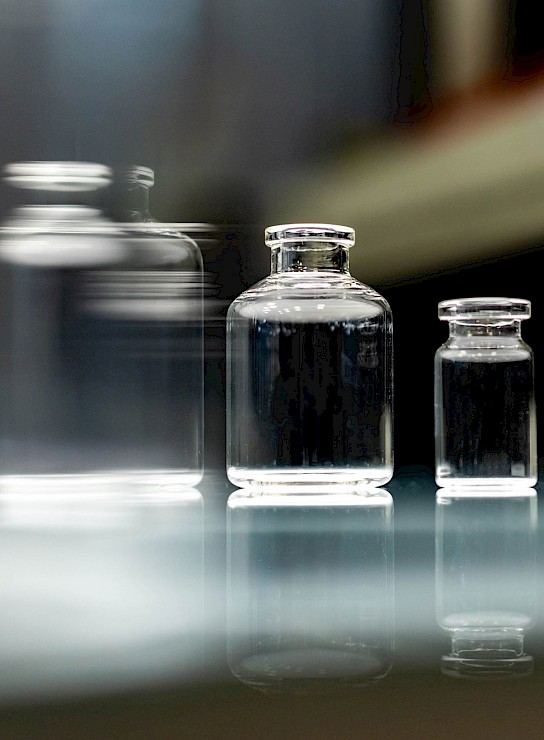
Two primary forms of glass delamination that can cause issues are flat laminated glass delamination and delamination in glass vials and other forms of pharmaceutical packaging.
In this blog, our technical glass experts will cover everything you need to know about both forms of glass delamination, including what they are, their risk factors, and appropriate screening procedures.
What is laminated glass?
Laminated glass is made from two panes that are permanently bonded with interlayers. These interlayers hold the glass together and create a strong and uniform layer.
What is laminated glass delamination?
Delamination of laminated glass usually occurs at the edge of the glass pane, which is sometimes referred to as interlayer or edge staining. It’s most common in laminated glass where a Poly-vinyl Butyral (PVB) interlayer is used, and it results from a reduction or complete failure of the adhesive bond between the glass panes.
What can cause laminated glass delamination?
Most laminated glass PVB delamination issues are caused by water immersion, so it’s essential to consider a water drainage solution. If water collects inside the channel, it can seep into the interlayer and the glass panes, causing them to separate over time. Rainwater can also collect in the tiny groove at the top of the laminated glass, although this is less likely.
Other laminated glass defects
In addition to delamination, there are several other defects which can affect laminated glass:
- Air Bubbles are spherical shapes of air pockets or volatiles in the glass that can’t be moved by finger pressure. They can be caused by inadequate de-airing.
- Air pockets are larger amounts of air or volatiles in the glass, which can be ‘worm-like' or ‘sunburst-like'. These are also caused by inadequate de-airing.
- Edge cracks. The edges of laminated glass are more vulnerable to cracking, especially if they are not properly finished or protected.
- Warping or bowing. This can be caused by temperature changes or uneven pressure during the glass manufacturing process.
What is delamination in pharmaceutical glass packaging?
Glass delamination is a common cause of product recall, which can be costly for manufacturers in the pharmaceutical industry.
Delamination of the glass surface occurs when sodium and other ions leach out of the glass surface into the solution. This leaves a predominantly silica surface layer, which may become detached from the glass and enter the solution as a thin flake. This is known as lamella, which is characteristic of delamination.
However, testing is needed to determine if visible flakes are delamination or if they result from another process unrelated to the glass product, such as a reaction within the drug product itself.
Risk factors of delamination in glass vials
- Flameworking tubular vials can make them more susceptible to delamination. This is because the boron and sodium volatilise and react with the colder glass. The reaction creates a band rich in boron and sodium, which reduces durability.
- The vial contents can also be a risk factor for delamination:
- The higher the pH, the more risk of delamination.
- Some buffers, such as phosphates and citrates, can accelerate the delamination process. They can migrate into the glass's porous structure and encourage it to detach.
- Sodium salts can increase pH, which increases the risk.
- The higher the ionic strength, the higher the risk of delamination.
- Elemental interaction can also affect the delamination risk.
Methods of screening for glass delamination on pharmaceutical vials
USP 1660 Glass Delamination on Pharmaceutical Vials provides information and guidance on testing procedures.
Testing should look for the precursors to lamination:
- Inner surface condition
- Extracted elements
- pH (as an indicator)
There are a range of analytical methods for screening for glass delamination:
- X-Ray Fluorescence (XRF) is a cheap and quick way to compare glass and get a general idea of its durability.
- Methyl Blue Test. This simple test gives an indication of the corrosion, surface changes, and their location in the glass. It needs to be used carefully and in conjunction with other methods.
- pH/Conductivity is the basis of the titration method. However, this isn’t enough to get the full picture of what is happening.
- Optical/Visual Inspection. Following accelerated tests and long-term storage, we can use simple visual and optical techniques to assess whether particulates are formed within the solution.
- SEM Analysis of the Glass Surface. This is designed to distinguish between general glass attacks and specific features typical of delamination, such as surface roughness and pitting.
- ICP Analysis of Released Elements (Si, AI, B, Ca). ICP is a technique for determining the quantity of select elements in samples using high-temperature plasma and a spectrometer.
- Particulate Analysis. Delamination is confirmed by visual or SEM imaging of lamellae and pitting in the glass surface.
Delamination screening tests
Delamination screening tests are an essential tool in evaluating packaging suitability. There are generally two types of tests carried out: short-term aggressive tests and long-term suitability tests.
- This is a test protocol to encourage surface changes to allow direct comparison. This includes:
- Evaluating glass containers from different vendors/glass formulations/post-formation treatments.
- Lot-lot variation from individual vendors.
- Predicting surface durability.
- This is a long-term study designed to determine the suitability of a packaging system for a specific product. It mimics real-life storage conditions and has a less aggressive protocol. These long-term studies are used to:
- Evaluate glass containers from different vendors, glass formulations, and post-formulation treatments.
- Predict surface durability.
- Determine the suitability of a given glass container for a specific product and specific storage conditions.
How Glass Technology Services can help
As an independent test house and consultancy for the global glass supply chain, Glass Technology Services offers comprehensive glass delamination and stability testing.
We offer:
- investigative glass delamination analysis if delamination is suspected.
- Propensity glass delamination screening to assess a product’s potential delamination risk.
- Failure analysis for the delamination of flat delaminated glass.
Our testing includes the suggested approach detailed in the United States Pharmacopoeia (USP General Information Chapter <1660>, 'Evaluation of the inner surface durability of glass containers') and referred to in the European Pharmacopoeia/Pharmacopée Européenne (EP) Chapter 3.2.1.
Our expert services include
- analysis and investigations where delamination is observed or suspected
- compatibility screening of primary packaging options, such as glass vials
- contract analysis – including evaluating the inner surface durability of glass primary packaging, particle/flake filtration, filter paper observation, and both scanning electron and optical microscopy imaging
- accelerated attack protocols to predict the effect of long-term storage
- long-term and accelerated delamination propensity studies
If you have a question about our service or want more information about how we can help your business, please contact our team. We will be happy to answer your questions.
Free webinar: Glass surface durability and delamination
Get access to the webinar





